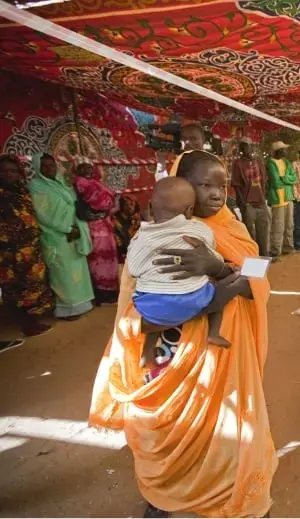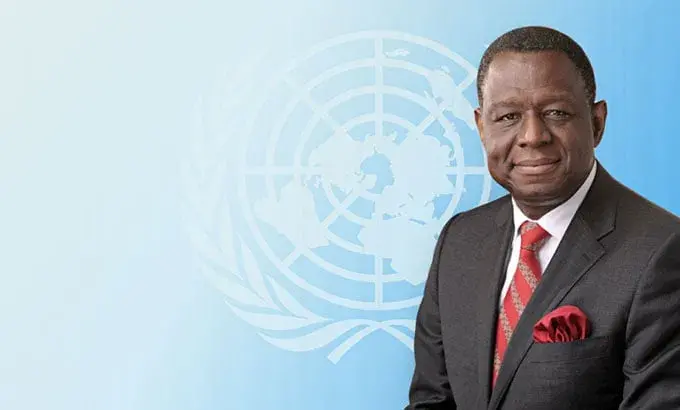HARARE, Zimbabwe—A young woman lies on a bed in Mutambara Mission Hospital’s maternity waiting home, looking tired but at ease. Chioniso Mutenda, 18, is 9 months pregnant. Just weeks earlier, her life – and that of her unborn baby – was at grave risk when one of the southern hemisphere's worst-ever cyclones hit.
“What we have come to know as Cyclone Idai started off with rains coupled with fast winds that were lifting things from the ground. The cyclone was powerful. It destroyed houses, buildings and swept away people,” Chioniso says.
In the room she is surrounded by other pregnant women, sitting on beds lining the walls as they wait to give birth.
“I was afraid I was going to lose my unborn baby,” the teenager says. “Many people had died and this thought consumed me.”
Chioniso is from Vimba in Chimanimani, one of the cyclone’s worst affected areas. In the immediate aftermath she knew she was lucky to have survived. But as information started to trickle in to her family's household, she heard that major roads and bridges had been destroyed. She realized she was in serious trouble.
This meant it would be difficult to get to hospital when the time came, and I was close to my expected delivery date.
“This meant it would be difficult to get to hospital when the time came, and I was close to my expected delivery date.”
Helping the most vulnerable people
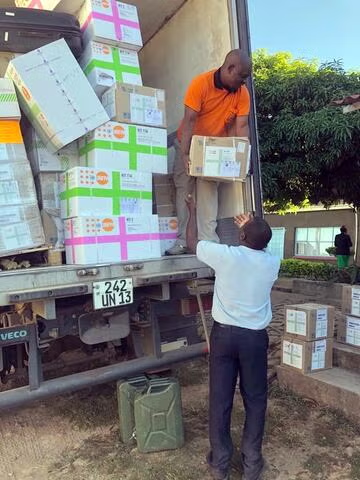
distribution at a health facility in Chimanimani.
UNFPA supported affected communities with the
kits as a humanitarian intervention.
© UNFPA Zimbabwe
Three countries were battered by the cyclone, described by the United Nations as one of the deadliest storms on record in the southern hemisphere. In Zimbabwe, Idai left a trail of destruction in Chimanimani and Chipinge districts. Here, the government reported 344 deaths and 257 missing.
When the extent of the devastation first became apparent, UNFPA staff at the offices in Harare knew that especially vulnerable women and girls like Chioniso would be in urgent need of humanitarian assistance, including critical sexual and reproductive health services.
This is because in Zimbabwe, complications during pregnancy and childbirth are the leading cause of death and disability among women of reproductive age (15 to 49 years).
But Chioniso’s situation was particularly worrying: pregnant teenage girls aged 15 to 19 years are twice as likely to die during childbirth as women aged 20 years and above. And now the flood waters had cut her off from basic supplies and the medical attention she would urgently need.
Walking to a health facility in my condition would have been impossible and giving birth at home was not an option.
“Walking to a health facility in my condition would have been impossible and giving birth at home was not an option – I needed professional health care,” she says.
This is why UNFPA staff were working with the government to put contingency plans in place for pregnant women and girls, to reach the most vulnerable first.
Cut off and losing hope
In the hard-hit villages of Rusitu and Vimba, which were difficult to reach even in military vehicles, Chioniso and five other young pregnant women were losing hope. All bridges to the region had been washed away, leaving them completely stranded.
With the roads cut off, it would not be possible for these pregnant women to quickly reach health facilities for timely services if the lives of both mother and baby needed to be saved.
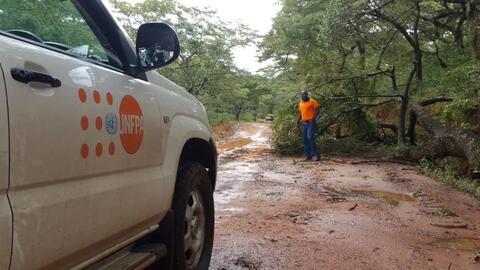
to enable safe passage into Chimanimani district, soon after Cyclone
Idai struck. UNFPA responded immediately to the sexual and
reproductive health needs to the affected communities.
© UNFPA Zimbabwe
“With the roads cut off, it would not be possible for these pregnant women to quickly reach health facilities for timely services if the lives of both mother and baby needed to be saved,” says UNFPA Country Representative, Dr. Esther Muia.
And Chioniso was not alone in her plight.
In the two affected districts, about 67,500 women of reproductive age would need sexual and reproductive health services; of these, 1,250 were pregnant and among them, 382 were living with HIV. In the three months following the cyclone’s destruction, UNFPA staff anticipated 3,750 live births, among which 560 women were expected to experience pregnancy and childbirth-related complications.
So, first to be prioritized were those women who were close to labour or at high risk. One of these would be Chioniso.
About 15 per cent of women who go into labour may develop a complication that needs the immediate attention of skilled healthcare attendants, Dr. Muia confirms. The agency’s priority was to move the women who were more vulnerable to childbirth complications to healthcare facilities.
And UNFPA and partners were working hard to reach them quickly.
Airlifting pregnant women to safety
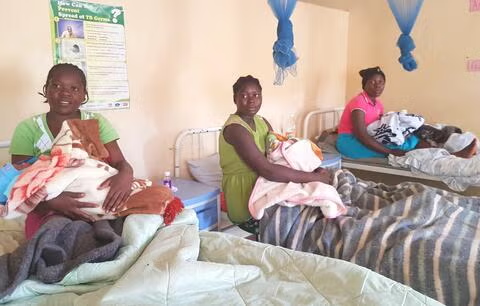
partners located heavily pregnant women and those identified at high
risk, and evacuated them first, by helicopter. © UNFPA Zimbabwe
“We decided to target women who were 36 weeks pregnant and above, and those with previous high-risk pregnancies, to be airlifted to the nearest health facility,” she said.
Using known health workers in the communities, critical messages were sent out to the stranded villagers. They were to report to the nearest schools where distribution of food supplies would take place. And pregnant women should report to a temporary clinic that had been set up at an identified school.
Chioniso and the five other young women were among 25 pregnant women who responded to the call. After the terrifying uncertainty, she was grateful to be receiving this support.
I was selected to be airlifted to Mutambara Mission because my due date was close. I became hopeful. I was happy.
“It did not take long for us to get registered. I was selected to be airlifted to Mutambara Mission because my due date was close. I became hopeful. I was happy.”
The airlifted women were taken to maternity waiting homes at Mutambara Mission Hospital, Chipinge District Hospital and Birchenough Bridge Hospital. And plans are at an advanced stage to move some of the women to a newly constructed maternity waiting home at Nyanyadzi Clinic.
With a smile on her face, Chioniso cannot hide her joy at being airlifted in a helicopter – and being safely installed at the hospital’s maternity waiting home. For now, she puts aside her sorrow at being separated from her family - giving birth safely must take priority.
Helping expectant mothers with mama kits
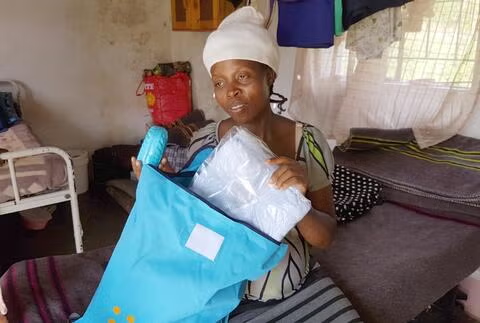
bought for the baby." Tatenda Sithole, from Rusitu, looks through
the items in her 'mama kit' – bath soap, backpack, bath towel,
baby blanket, baby dress, diapers and a shoulder bag.
© UNFPA Zimbabwe
In addition to airlifting the most vulnerable women to safety, UNFPA through the Musasa Project and the International Rescue Committee is distributing ‘mama kits’ to expectant women, as many of them lost their baby clothes in the floods.
One of them is Tatenda Sithole, 23, from Rusitu in Chimanimani. Now safely housed at a maternity waiting home at Chimanimani Rural Health Centre, she is grateful for the mama kit.
“I had visited my mother in Ngangu when the floods struck. My mother’s house was completely destroyed but luckily we all survived. My husband eventually sent word that although he had survived, our home had been destroyed too. We lost all our belongings – including the new clothes we had bought for the baby,” she says.
We lost all our belongings – including the new clothes we had bought for the baby. I am happy to have received this kit.
“I am happy to have received this kit. It will help me dress my baby while I think of what to do next,” she smiles.
As the affected communities set about rebuilding their homes and lives, a significant statistic emerges: despite facing serious vulnerabilities in the flood-affected regions, not one pregnant woman or her newborn has been lost due to complications of pregnancy or childbirth.
Even here, safe births are assured.
– Jesilyn Dendere
Note: Zimbabwe President Emmerson Dambudzo Mnangagwa declared a state of disaster in the affected areas and launched a US$612 million Cyclone Idai international humanitarian assistance appeal to cater for survivors' health, food security and nutrition, emergency shelter and non-food items. The Zimbabwean government released additional health workers to healthcare facilities in the affected areas. The government response was being coordinated by the Department of Civil Protection through the National, Provincial and District Civil Protection Committees, with support from Sector Lead agencies and humanitarian partners.


